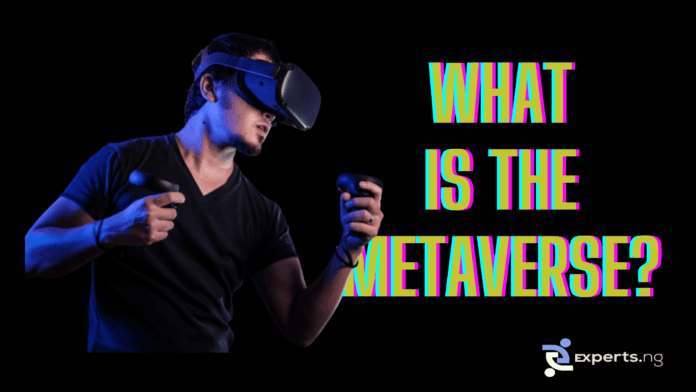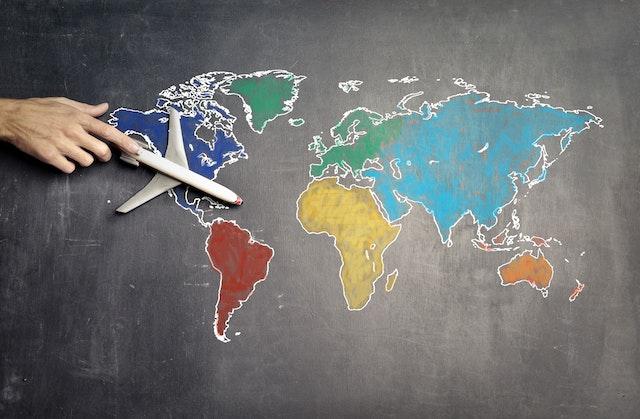When I wrote about NFT, I promised to dig into some of the other buzzwords in the world of tech. This is me keeping that promise, starting with this one that may change our world as we know it—introducing Metaverse!
You should have heard about the Metaverse by now; so hard to miss it with how popular it has become, especially after Facebook announced the change of its company name to Meta. In the video where he made the announcement, Mark Zuckerberg talked about how the company is positioning itself for the Metaverse, which he believes will change how we socialise, learn, shop and carry out our other daily activities.
Contents
What is Metaverse?
Metaverse is a combination of two words – Meta and Verse. As for the first, Meta, it’s typically a prefix in computer science that means ‘about’. For instance, Metadata is a type of data that tells more about other data.
On the other hand, Verse derives its meaning from the Latin word vertere, which literally means ‘to turn’. So “Universe” actually just means “one turn”.
Based on the above, we can conclude that the metaverse means data turn or data turning? Not exactly. The word Metaverse came to be through the combination of Meta to the verse in Universe, not necessarily based on the original meaning of the word verse, but instead based on its deductive meaning as it relates to the world as we know it.
Away from the word’s etymological meaning, Metaverse is a virtual-reality space where users can interact with a computer-generated environment and other users (Oxford Languages). Think of it as an imaginary world where everything possible in the world as we know it today would also be possible. Mind-blowing!
History/evolution of the Metaverse
The Metaverse, like anything else, went through different phases, with several contributory factors to get to where it is today. You probably already know that the number one important factor here is the internet – without the internet, the Metaverse concept would be inconceivable. Others include:
1992 – Snow Crash
In 1992, science fiction author Neal Stephenson conceived the concept of the “metaverse,” where humans act as avatars and interact with software agents in a three-dimensional virtual world inspired by the real world.
1993 – Proof of Work
In the context of computer security, the term and concept were introduced to prevent email spam. Over time, proof of work became one of the primary ways to verify and legitimise transactions on a blockchain, specifically computer-based currency mining.
1998 – B-Money
Computer engineer Wei Dei developed a decentralised, distributed cryptocurrency called b-money. Although it never happened, some concepts were similar to those found in Bitcoin, which emerged years later. A key component was the use of Proof of Stake, an alternative mining algorithm based on the developer’s current cryptocurrency holdings rather than raw computing power.
2002 – Digital Twins
Then at the University of Michigan, Michael Grieves presented the concept and model of the digital twin at a Society of Manufacturing Engineers conference in 2002. Digital twins were introduced by Grieves as a model of product lifecycle management.
2003 – Second Life
In 2003, Philip Rosedale and his team at Linden Lab created the online virtual world Second Life. This was an essential precursor to today’s Metaverse worlds. It was a less-than-optimal experience due to low bandwidths and slow “res” times for Second Life users. Despite this, there are still over a million active Second Life users, each spending over four hours a day in this virtual world.
2006 – Roblox
The online platform offered users the opportunity to create and play games developed by other users. When the pandemic began in 2020, it became a significant source of interaction among young people, ranking third among games in terms of gross sales.
2009 – Bitcoin
In 2009, Satoshi Nakamoto, the mysterious creator of bitcoin, mined the genesis block of bitcoin (block number 0) for a reward of 50 bitcoins, which launched the bitcoin network.
2009 – Blockchain
In addition to creating Bitcoin, Satoshi Nakamoto also created blockchain to serve as the public ledger of Bitcoin transactions.
2010 – Play-to-Earn Technology
The Gacha system began as a game in MapleStory in the early 2010s, based on the concept of capsule toy vending machines. To earn currency, players would engage in random draws from a set of items based on predetermined rarities, often to earn powerful in-game rewards by collecting all the items in one set.
2011 – Ready Player One
Many young people were introduced to the concept of virtual reality through this novel by Ernest Cline. Steven Spielberg’s 2018 film adaptation made the idea even more vivid and became more popular.
2012 – NFTs
An NFT or “Nifty” is a Non-Fungible Token representing a unique item rather than fungible tokens like Bitcoin, which are interchangeable. NFTs have been around since December 2012 with the creation of coloured coins, in which additional information is incorporated onto bitcoins to become unique instead of fungible. A young Vitalik Buterin was the man who spearheaded this effort to improve the Bitcoin blockchain.
2014 – Vitalik Buterin
Paypal came to life when Peter Thiel’s Confinity merged with Elon Musk’s X.com in 1999. eBay bought PayPal three years later for $1.5 billion, making Musk and Thiel extremely wealthy. In 2010, Peter Thiel announced the creation of the Thiel Fellowship, a $100,000 grant meant to encourage students under the age of 22 to leave school and pursue other careers. Vitalik Buterin, the co-creator of Ethereum, was one of the grant recipients in 2014.
2015 – Ethereum
The Ethereum Network, along with the Ethereum blockchain, was launched in July 2015 by Vitalik Buterin and Gavin Wood.
2015 – Decentraland
In 2015, this platform’s first iteration was introduced. It assigned “land” based on a proof of work algorithm. Real estate plots in the game have sold for more than $100,000 due to the 2021 NFT boom.
2015 – Smart Contracts
Nick Szabo coined the term “smart contract” in the early 1990s to refer to “a set of promises specified in digital form and protocols that enable parties to perform on those promises.” Following the launch of the Ethereum blockchain, the term “smart contract” has become more specific to general-purpose computations performed on a blockchain.
2016 – Pokémon GO
A virtual world was overlaid on the real world for the first time in Pokémon Go. This gaming app uses GPS technology to locate, capture, train, and battle virtual creatures, dubbed Pokémon, that appear to be in the player’s real-world location.
2016 – The DAO – Decentralized Autonomous Organizations
In May 2016, a crowd-funded token sale launched the DAO, which set the record for the most extensive crowd-funding campaign in history. The plan was to create a decentralised venture capital fund based on Ethereum’s blockchain. Using a vulnerability in The DAO code, users could siphon off one-third of the project’s funds into a subsidiary account in June 2016. This led to the demise of The DAO as an entity. However, the concept of decentralised autonomous organisations (DAOs) is still relevant, albeit greatly improved from lessons learned from DAO’s experience.
2017 – Fortnite
Upon its release, this multi-player video game became a massive success, and it got many people interested in the look and feel of the metaverse and cryptocurrency.
2018 – Dai Stablecoin
Adding a stablecoin to an otherwise volatile crypto market was one of the goals of Dai Stablecoin. Pegged to the US dollar, a centralised Dai Stablecoin became considerably less volatile and more reliable than cryptocurrencies whose value has no link to any fiat currency or linked to other cryptocurrencies.
2018 – Decentralized Exchanges (DEX)
Bancor was hacked and lost $13.5 million, causing a significant PR setback for cyber currency exchanges. Despite their uncertain legal and regulatory foundation, DEXes still serve a purpose as a way for people to transact in their cyber currencies person-to-person instead of through centralised exchanges.
2018 – Axie Infinity
The popular NFT virtual reality game, Axie Infinity, was introduced in 2018. By mid-2021, it was the platform with the highest total market value of all play-to-earn games.
2020 – COVID
In the wake of COVID’s outbreak in 2020, most of the world’s population was on lockdown, leaving them with few options. Because of this, the Metaverse has quickly become a popular destination for young people, gamers, and those who want to make money online. Metaverses are rebelling against real-life institutions in today’s polarised world – the more ingrained they are, the more they are at risk.
2020 – Decentralized Apps (Dapps)
Over $2 billion worth of tokens has exchanged hands on six major blockchain platforms. There has been a move towards cutting out the middleman, as open-source, transparent applications have continued to emerge to enable games, DEXes, Defi, and other acronymised uses. Despite the belief that dapps are an emerging trend, the first dapp was the Bitcoin app over a decade ago.
2020 – First Concert in the Metaverse
Approximately 30 million people watched Travis Scott and Marshmello perform in Fortnite in April 2020.
2020 – Solana
A blockchain dapp, Solana, was introduced in April 2020. SOL, the cryptocurrency used by this dapp, is mined with an alternate proof of stake algorithm (POS) instead of Ethereum. Furthermore, ownership issues were clarified and simplified with Solana’s “proof of history” consensus tool, which inserts timestamps into its blockchain.
2020 – Alien Worlds
A wildly popular dapp, that uses a multi-metaverse interplanetary plot to have NFT characters interact in a decentralised organisation to perform tasks such as mining tokens. By 2021, Alien Worlds had more than 2.5 million users, but its significance goes beyond that – the purpose of the game is to teach people about cryptocurrencies and crypto-mining.
Source: Futurist Speaker
How will the Metaverse work?
From an individual point of view, it would mean that you could meet up with friends or potential friends no matter where they are. Additionally, compared to facetime or chatting, it would offer a far richer, almost real-life experience. However, as with any new medium, active “players” are essential for success.
How will the Metaverse affect businesses?
It will provide a range of opportunities for businesses. Virtual offices will be like nothing else we’ve ever seen. Companies with offices in different countries will probably feel a lot more connected. You could attend virtual meetings with international colleagues and even arrange a virtual after-work social event with this new technology. Additionally, businesses could hire employees based in other locations to a greater extent. Another significant aspect of this is that it also offers employees the opportunity to learn different technologies more efficiently. Virtual reality allows us to create simulated scenarios to train employees without physically having them present.
However, its success beyond the VR goggle phase will require further development. With time and different iterations, we can assume it will be as seamless as some episodes in Black Mirror, where it is just a sort of device you wear around your neck. We should also consider the issue of security, and how we can protect our integrity and individuality regardless of whether or not we are on the internet. Although we are already doing so, considering you as an individual will be travelling data between networks instead of a chat message, it is worth considering.
How will the Metaverse affect politics?
In terms of politics, while this aims to bridge the distance gap and create a globalised world, it also threatens equality. Not everyone can afford a smartphone or laptop, and the internet connection is still relatively slow in some parts of the world (Nigerians say hi). There is no doubt that this will have a role to play here since we can assume that those who cannot afford a phone will also not be the first to purchase a VR headset—adding to the gap between connected and disconnected people.
Conclusion
Metaverse is one more proof that change is inevitable, and all you have to do is embrace it. Is it going to be perfect from the go? I think not. It’s going to come with its challenges with several criticisms and critics. But it’s only going to keep getting better.
Can it possibly be used for ulterior motives by big tech companies and fraudulent individuals? You can’t rule any of these out judging by antecedents. But, again, it will keep getting better, and the positives sure outweigh the negatives.



























Beautiful piece!
You won’t believe this, but I just got to know the term “metaverse” for the first time from this piece. This is expository
Oh, wow.
Glad to introduce you to the metaverse, lol
Thanks for stopping by Charles, was really happy to see your comment?
sandsan b0da67c006 https://marketplace.visualstudio.com/items?itemName=Wizarada.Hindi-Tv-Serial-Songs-Star-Plus-Gulal-Piyu-Mari-O-Pyarimp3
obeken 5052189a2a https://www.guilded.gg/traladcanes-Hurricanes/overview/news/2l3VDx8R
Due To This Fact, for these seeking a pure, secure, and efficient supplement,
Prime Labs steroids stand out as a commendable selection. Prime Labs Testosterone Booster is
a natural dietary complement that’s specifically designed
to increase testosterone levels in males. Testosterone is
a hormone that performs a crucial position in males’s
well being, together with muscle growth, vitality ranges, and overall vitality.
This booster works through the use of a mix of powerful elements that assist to naturally stimulate the production of testosterone within the body.
By doing so, it offers numerous benefits such
as improved muscle mass, enhanced stamina, elevated libido,
and improved general well-being. If you’re in search
of a safe and efficient method to improve your testosterone ranges, Prime Labs
Testosterone Booster could be the perfect answer
for you.
Mega-steroids supply the best high quality
of anabolic steroids and provide wonderful customer service.
Speaking from personal expertise, after I first came across Prime Labs Prime Check,
I was intrigued by its distinctive blend of ingredients.
I had experienced a plateau in my exercises and
was on the lookout for one thing pure to give me that further push.
After a couple of weeks on this complement, I did discover
a significant change in my power levels and general vigor.
While individual outcomes could differ, understanding the ingredients and their potential advantages is essential to
appreciating what this complement provides.
We’d review Saw Palmetto as a fatty acid that comes from Serenoa Repens is thought to help
reduce prostate progress. There is potential for this to assist if you are affected by benign prostatic hyerplasia (enlarged prostate) or having
trouble with urination. We’ll select the individual elements
and see how efficient they are for raising T or treating low testosterone.
HGH is no longer the domain of the most superior and hardcore bodybuilders.
HGH is not legal to use for efficiency or bodybuilding functions or any
use outside prescribed medical settings. All
off-label prescribing of HGH is against the law in the Usa
and Most popular steroid different countries.
Anybody who has used real pharmaceutical-grade HGH will usually
say it was well value their funding.
HGH’s advantages lengthen beyond physique enhancement and embrace benefits to the joints, pores and skin, bones, restoration, sleep, and mood.
Not Like testosterone, which most steroids
are based on, HGH just isn’t a male hormone, and meaning females can use HGH just as equally
as men with out the adverse results that steroids cause.
To sum up, while Prime Labs testosterone booster could be effective on its own, there are certain dietary and
life-style recommendations that can enhance its effectiveness.
Bear In Mind to consult with a healthcare skilled before starting any new complement routine, particularly if you have any
pre-existing health circumstances. It can be price mentioning that
testosterone boosters usually are not an different selection to a wholesome life-style.
Good diet, regular train, and enough sleep are key elements
in optimizing testosterone levels naturally. Subsequently, it is
advisable to focus on these foundational aspects earlier than resorting to supplements.
You could be stunned to search out an ingredient like Wild Yam Extract in a male supplement,
however its benefits are notable. It’s identified to control hormones, alleviate cramps and
muscle ache, and even increase energy ranges. It’s an all-rounder that complements the other elements
on this supplement. This extract is derived from a type of palm tree and has a long
historical past of use in traditional medicine. It’s known for supporting prostate well being, lowering hair loss, and boosting testosterone levels.
Not solely an essential part of bodily improvement,
it contributes tremendously to muscle growth, but in addition to competitive edge in sports
activities the place physical health is of the utmost significance.
Assume of it as a guard, keeping the undesirable unwanted effects of estrogen at bay.
You get to maintain your muscular tissues trying sharp and defined without
the worry of water retention softening their look.
Correct food plan, common train, and enough sleep are foundational for good
well being and reaching desired results in any health or
bodybuilding journey. Right dosage is the key to harnessing the benefits of any complement while minimizing potential adverse reactions.
Taking too much can lead to amplified unwanted effects, whereas taking too
little might not give the specified results.
Athletes resolve to purchase Oxandrolon to extend power and
endurance and improve physique definition. If you’ve learn enough about Prime
Test, and wish to transfer on right away to one thing formulated with high quality
components proven to extend Testosterone, I don’t blame you.
Here are the tried-and-true supplements we’ve extensively researched.
In some cases, the revealed data had to be manually tailored and transferred to suit our classification system.
This additionally could have led both to over or under estimation of sure proportions of the estimates of “substandard” or “counterfeit” anabolic androgenic steroids and their subclassifications and sub-analyses.
Physicians should be conscious of T-Booster contentsand their efficacy to better counsel sufferers.
Our evaluate revealed that solely limited, flawed human research have evaluated efficacy ofsome
of the commonest elements in these dietary supplements,
with no definitive findings. In the absence of more definitive human knowledge,sufferers must be cautioned earlier than considering the use
of T-Boosters, significantly given the supply of
highly efficient drugtherapies. The prime 5 T-Boosters had an average ± SD of 2,
761 ± 5,112 reviews and a score of 4.56 ±
zero.25stars. Amongst 37 human studies, 30% observed an increase in Tlevels, 3% a decrease, 46% no impact, and 22% were indeterminate.
Evaluation of prime customer critiques from the primary two pages ofreviews for each supplement revealed variations in ADAM score before and after ReviewMeta.com filtration.
Testosterone Propionate and Trenbolone Acetate are both anabolic steroids used to promote muscle growth and improve physical
performance. Testosterone Propionate is a fast-acting form
of testosterone, which helps in rising lean muscle mass, improving strength, and enhancing restoration times.
It is often used by athletes and bodybuilders for its muscle-building and
performance-enhancing results. Trenbolone Acetate, then again, is known for its
highly effective anabolic properties, significantly boosting muscle mass and energy, whereas also reducing physique fats.
It is considered one of the most potent steroids available and is in style among these trying to achieve important physique modifications.
Both compounds have strong anabolic effects but come with potential unwanted
aspect effects, including however not restricted to hormonal imbalances,
cardiovascular risks, and mood adjustments.